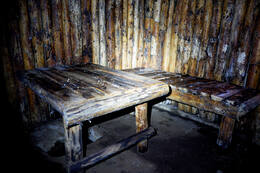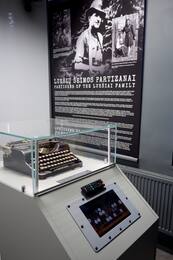Sklidžiai with "Neptune": MGB poison for partisans
In 1955, the partisans of Samogitia became victims of a treacherous operation by a Soviet MGB agent - honey-filled slurries poisoned with special preparations were intended to kill the freedom fighters.
In 1949, the MGB began using special means - sleeping pills, codenamed "Neptun 12", "Neptun 22", "Neptun 80", which were mixed into alcohol or food.
A tragic event occurred in 1955 in Samogitia. Partisan supporter, and in fact MGB agent Adolfas Šliažas from the village of Laumakiai, fed three partisans - Steponas Erstikis-Patašonas, Kostas Lyuberskis-Žvainiai and Julius Adomaitis-Erdvilas - with honey-laced scallions, which were laced with MGB poison. Even the agent himself, after tasting the poisoned scallions, ended up in Meškuičiai Hospital.
Despite his condition, Julius Adomaitis-Erdvilas, having eaten only one leaf, saved his friends: "he dragged his unconscious comrades through the forest away from the dangerous place, until his own strength abandoned him." The effect of the poison was terrible - the partisans wandered through the forests for a long time in a darkened state. The security forces did not find the partisans at that time, but only collected the things they had thrown away: ammunition, notes, newspapers and Erdvilas' diary.
Related timeline
Related objects
The headquarters bunker of the Žvelgaitis team
The bunker is located in the Gulbinai Forest.
The Kunigaikštis Žvelgaitis detachment was a Northern Lithuanian partisan unit belonging to the Prisikėlimų apygardas, which fought against the Soviet occupation from April 1948 to May 1952. The detachment operated in Joniškis County and part of Šiauliai and Mažeikiai Counties.
The Žvelgaitis squad had a hideout in the Gulbinai forest, which was discovered by soldiers of the MGB internal security unit on March 19, 1952. At that time, 5 partisans from the headquarters of the Prisikėlimų district Kunigaikštis Žvelgaitis squad were in the bunker, 3 of whom - Boleslovas Kriščiūnas-Puntukas (squad commander), Izidorius Miškūnas-Barzda (chief of the squad headquarters) and Stasys Šepkus-Šernas (chief of the Intelligence Department of the squad headquarters) were killed.
The last partisans of Prince Žvelgaitis's squad, Steponas Erstikis-Patašonas, Konstantinas Liuberskis-Žvainys and Julius Adomaitis-Erdvilas, published the newspaper "Partizanų šūviams aidint" (In the Echo of Partizan Shots) in 1952–1956, and "Partizanų šūvių aidas" (Echo of Partizan Shots) in 1956–1957.
In 1998, the bunker was restored, a memorial plaque was installed, and a memorial cross, created by folk artist A. Ganusauskas, was erected near the bunker.
Joniškis History and Culture Museum
Joniškis Museum of History and Culture was established in the centre of Joniškis in 1989. It features exhibitions reflecting the historical and archaeological treasures, ethnic culture and sacred art heritage of the region. Based on the initiative of historian Darius Vičas. The museum has an exhibition dedicated to the partisans of the Joniškis region. In a separate room, you are introduced to the personalities of partisans – fighters for Lithuanian freedom – and their struggle against the Soviet occupation. The exhibition features an authentic Olympia typewriter that served the last partisans of the Joniškis region, Kostas LiuberskisŽvainys and Steponas Erstikis-Patašonas. It was used to print issues of the partisan periodical “Partizanų šūvių aidas” (Echo of Partisan Shots). The underground newspaper was published from 1952 to 1957 in the territory of the Juozapavičius homeland (on the outskirts of Akmene, Joniškis, Žagarė and Kuršėnai districts). It is the last periodical published by partisans. The typewriter has been modified for interactive access to information – by pressing its keys, visitors see photos and hear stories about the partisan resistance. The radio receiver in






